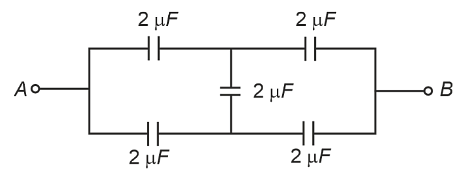In the following circuit, the equivalent capacitance between terminal A and terminal B is :


- 2 µF
- 1 µF
- 0.5 µF
- 4 µF
The Correct Option is A
Solution and Explanation
To determine the equivalent capacitance between terminal A and terminal B in the given circuit, let's analyze the configuration step by step.
Circuit Analysis:
The circuit consists of four capacitors, each with a capacitance of 2 μF, arranged in a diamond shape as follows:
- Two capacitors are connected in series on the left side.
- Two capacitors are connected in series on the right side.
- These two series combinations are then connected in parallel between terminals A and B.
1. Series Combination on the Left Side:
Capacitors: 2 μF and 2 μF in series.
Equivalent capacitance for series:
$ \frac{1}{C_{\text{series}}} = \frac{1}{2} + \frac{1}{2} = 1 $
$ C_{\text{series}} = 1 \mu F $
2. Series Combination on the Right Side:
Capacitors: 2 μF and 2 μF in series.
Equivalent capacitance for series:
$ \frac{1}{C_{\text{series}}} = \frac{1}{2} + \frac{1}{2} = 1 $
$ C_{\text{series}} = 1 \mu F $
3. Parallel Combination of the Two Series Pairs:
The two 1 μF equivalent capacitors are now in parallel.
Equivalent capacitance for parallel:
$ C_{\text{parallel}} = 1 + 1 = 2 \mu F $
Final Answer:
The equivalent capacitance between terminal A and terminal B is: $ 2 \mu F $
Top Questions on Capacitors and Capacitance
- A capacitor is charged by a battery to a potential difference \( V \). It is disconnected from the battery and connected across another identical uncharged capacitor. Calculate the ratio of total energy stored in the combination to the initial energy stored in the capacitor.
- CBSE CLASS XII - 2025
- Physics
- Capacitors and Capacitance
- “There is a limit to the amount of charge that can be stored on a given capacitor.” Explain.
- CBSE CLASS XII - 2025
- Physics
- Capacitors and Capacitance
- The plates of a parallel plate capacitor are separated by d. Two slabs of different dielectric constant \(K_1\) and \(K_2\) with thickness \(d/2\) and \(d/2\) respectively are inserted in the capacitor. Due to this, the capacitance becomes two times larger than when there is nothing between the plates. If \(K_1 = 1.25 K_2\), the value of \(K_2\) is :
- NEET (UG) - 2025
- Physics
- Capacitors and Capacitance
- Two capacitors $ C_1 = 4\mu F $ and $ C_2 = 6\mu F $ are connected in series across a 60 V battery. The potential difference across $ C_2 $ is:
- BITSAT - 2025
- Physics
- Capacitors and Capacitance
- A parallel plate capacitor of capacitance 1 μF is charged to a potential difference of 20 V. The distance between plates is 1 μm. The energy density between the plates of the capacitor is:
- JEE Main - 2025
- Physics
- Capacitors and Capacitance
Questions Asked in NEET exam
- A microscope has an objective of focal length \(f_o = 2\) cm and an eyepiece of focal length \(f_e = 4\) cm. The tube length of the microscope is \(L = 40\) cm. If the distance of distinct vision of eye is \(D = 25\) cm, the magnification in the microscope is:
- NEET (UG) - 2025
- Optical Instruments
- Which one of the following is an example of ex-situ conservation?
- NEET (UG) - 2025
- Ex-Situ Conservation
- Which one of the following compounds can exist as cis-trans isomers?
- NEET (UG) - 2025
- Organic Chemistry
- Who proposed that the genetic code for amino acids should be made up of three nucleotides?
- NEET (UG) - 2025
- Molecular Biology
- An electron (mass \(9 \times 10^{-31}\) kg and charge \(1.6 \times 10^{-19}\) C) moving with speed \(c/100\) (\(c\) = speed of light) is injected into a magnetic field of magnitude \(9 \times 10^{-4}\) T perpendicular to its direction of motion. We wish to apply a uniform electric field \( \vec{E} \) together with the magnetic field so that the electron does not deflect from its path. (speed of light \(c = 3 \times 10^8\) m/s):
- NEET (UG) - 2025
- Electric Field